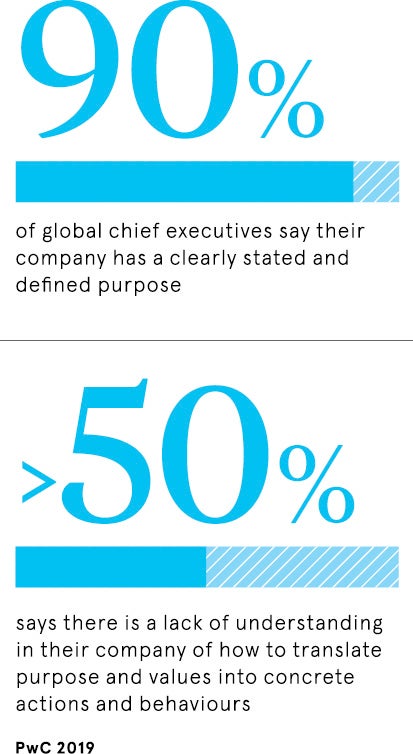Successful businesses have gone beyond the idea of corporate social responsibility as an afterthought and now place company purpose at the heart of their strategy. But building from the ground up is easier than shoehorning company purpose in at a later stage, so how can older institutions retrofit purpose in an authentic way?
New research from Business in the Community’s Responsible Business Tracker has revealed that, although 86 per cent of companies surveyed have a purpose statement, the majority (83 per cent) have not yet considered what this means across departments or set clear team targets. The research found a clear gap between company purpose statements and integration with clear targets across departments.
Learning from startups
Many newer companies are already doing this well. As Mike Foster, creative director and founder of Straight Forward Design, says: “Starting from scratch means you’re beginning with modern thinking and tools to get to a positioning and purpose that will resonate with tomorrow’s consumers.”
Fintech firm Finastra has succeeded in placing company purpose at the heart of its business activities. Formed following the combination of two global firms Misys and D+H, the firm has actively embraced the purpose of “openness” across the company.
“At Finastra we made the decision to reposition ourselves from a core systems provider to a truly open platform, meaning we had to practise what we preached, building an open and inclusive workforce, openness in our brand and language, opening up our hierarchy, as well as opening up our tech,” says chief marketing officer Martin Häring.
“Saying something doesn’t make it true; really living it, championing it and celebrating it is the only way to drive it forward. It’s having one eye on what we were born to do and one on what we could achieve.”
Company purpose is discovered, not created
If company purpose is suddenly on your agenda because you’re reacting to competitor moves, then you’re hitting your first barrier: authenticity, says Philip Davies, president, Europe, Middle East and Africa, at global brand strategy firm Siegel+Gale. “Purpose is not created, but uncovered, and when it’s found and clearly communicated, it can be a magnet for like-minded people who want to be associated with the brand, as a consumer or an employee or otherwise,” he says.
Take lessons from the authentic brands
Joy Parkinson, chief executive of Faith In Nature, whose mission since it was founded in 1974 has been “to be kind to the planet and people’s skin”, puts company purpose at its core, informing every decision since the start.
Ms Parkinson says: “I would advise any business looking to retrofit purpose authentically to start by redefining their ‘why’. Why are we doing what we do? And the ‘why’ has to be genuine; it has to be based on a truth. It has to be something the senior players in the business are absolutely passionate about. Once a company has a strong ‘why’ everything else flows from that; it will help the board to decide on its strategic direction and inform decisions made throughout the business.”
Buy-in is crucial
In the arms race for talent, purpose is no longer a nice to have, says Gabbi Cahane from brand consultancy Multiple. “Purpose has become a vital component of the competitive toolkit,” he says.
“Purpose and culture should go hand in hand and increasingly CEOs should be utilising culture to supercharge progress, performance and productivity across every organisational dimension. To ensure all employees buy into the purpose, the leadership team must lead by example, role modelling, and reinforcing the purpose and culture from the top down.
Saying something doesn’t make it true; living it, championing it and celebrating it is the only way to drive it forward
“Equally, they should engage employees in the process of defining or refining the purpose from the bottom up.”
 Putting together a cross-functional team that represents all areas of the business to undertake this work is an effective way to ensure talent from the frontline, factory floor, back office and the boardroom all have a voice in the process. “These people become advocates right across the company, enabling organisation-wide buy in,” says Mr Cahane.
Putting together a cross-functional team that represents all areas of the business to undertake this work is an effective way to ensure talent from the frontline, factory floor, back office and the boardroom all have a voice in the process. “These people become advocates right across the company, enabling organisation-wide buy in,” says Mr Cahane.
Take baby steps
Outsourced communications provider Moneypenny has had its workplace and ethos in place since it started in 2000. This purpose, says chief executive Joanna Swash, is what has made it so successful, with a “fantastic, happy, positive team”.
Ms Swash believes creating a great culture means its people will be happy, remain for the long term and offer clients a good service, placing staff at the heart of everything it does. This approach has worked well for the company, which has low staff turnover and says it receives more than 3,000 unsolicited CVs every year.
But it doesn’t happen overnight. “When adopting a new purpose, it is essential you don’t throw the baby out with the bath water,” she says. “Take tiny baby steps and install an open communication. Decide what you want and what your end-goal is then work out the interim steps needed to get there.” Every small interaction is important, whatever it might be, but “ensure each one is brilliant,” Ms Swash concludes.
Learning from startups






